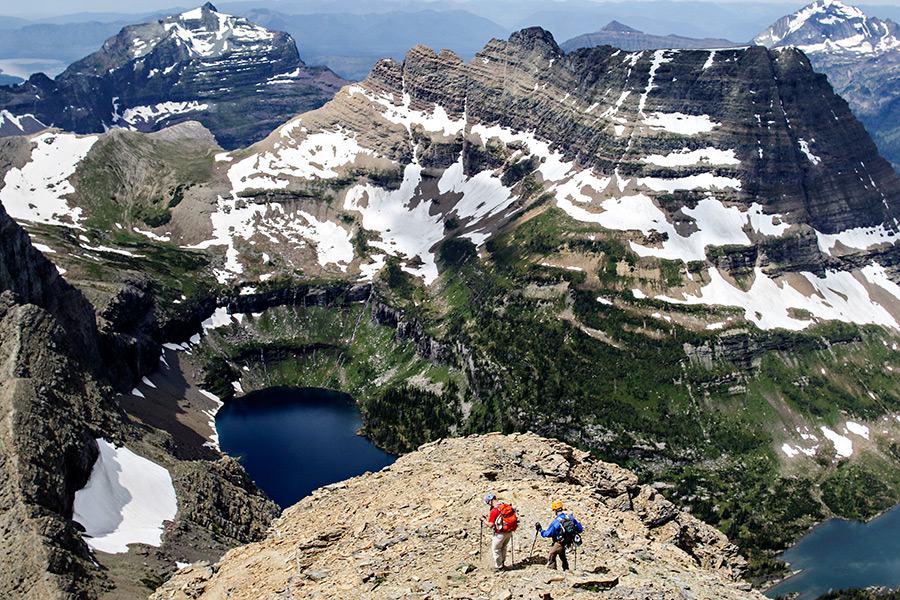A century ago, the National Park Service’s inaugural director was faced with competing visions for how visitors would experience Glacier National Park, the heart of the Crown of the Continent ecosystem where natural processes were mostly unimpeded.
It was 1918 and preparation was underway for the sprawling Going-to-the-Sun Road, the alpine mountain highway that cuts through the heart of Glacier and today leads throngs of visitors on a tour of its wild interior.
The National Park Service’s Chief Engineer George Goodwin had proposed a route that followed the Logan Creek Valley, ascending about 2,600 feet to Logan Pass. The proposed route crossed Logan Creek seven times in a series of hairpin turns, or switchbacks, ascending the steep slope. Goodwin claimed that this direct route would “meet every requirement for park travel or commercial hauling.”
As plans were being laid, Stephen Mather, the inaugural director of the National Park Service, went to Glacier during the summer of 1924 to inspect the proposed route with Goodwin, as well as the National Park Service’s landscape engineer, Thomas Vint, and the park superintendent. Dismounting a few miles west of Logan Pass, the group took in the view of Logan Creek and the summits of the Livingston Range that marked the Continental Divide down the center of the park. Dominated by the huge, almost vertical cliff called the Garden Wall, the green valley of Logan Creek provided the foreground of a stunning panorama of the Glacier high country.
Vint complained that building switchbacks up the valley would make it look “like miners had been in there,” and instead urged the director to replace the series of switchbacks with a road carved directly into the rock of the Garden Wall, which would require just one switchback but called for a more challenging and expensive design, even if it was more elegant.
For Mather, the choice was clear, even if the more complicated route was not.
“Ultimately Mather chose the more delicate road with a single switchback because he recognized that this was not a utilitarian road,” Michael Jamison, program director for the National Parks Conservation Association’s Glacier field office, said. “He recognized that there was an aesthetic. This had more to do with culture than it had to do with efficiency in getting across a mountain. Those were very deliberate choices that were made. It’s an incredibly rare legacy of public land that we’ve inherited and it was very purposeful and intentional. We have an obligation to what we’ve inherited at some level. So let’s make good choices.”
Today, those choices are more consequential than ever as the vision for the next century of protection and connection takes shape across the nation’s suite of parks, emerging as a prominent point of discussion for stakeholders charged with informing and influencing the future of public lands.
Last week, many of those stakeholders gathered in Helena to celebrate the centennial of the National Parks Conservation Association (NPCA), an organization that serves as an outspoken advocate for parks and their neighboring communities, attendant cultures and natural settings.
It’s no coincidence that the same man who led the formation of the agency designed to unify and manage the nation’s growing number of parks, Mather, also created the independent organization of informed citizens to serve as their voice.
National Parks serve a dual role as big ticket draws to visitors as well as sanctuaries for large, intact ecosystems and the wildlife that inhabit them.
As recreation economies like Montana’s surge — recent data from the U.S. Bureau of Economic Analysis pegs the Treasure State’s total outdoor recreation value at $2.3 billion — a new era is dawning over a landscape that defines cultural identities as much as it serves as a conservation tool.
“These are the beating hearts of our ecosystems and our economies,” Jamison said of the parks system. “So if our future ecology and our future economy and our future identities depend on them, then it is probably worth having a plan for how we live next door to them.”
Still, what’s good for community isn’t necessarily good for conservation, and vice versa. With that in mind, the NPCA’s centennial celebration was dominated by conversations about how to improve symbiotic relationships across the landscape in an effort to benefit culture, community, conservation, and economies.
“One hundred years ago, it was all about drawing lines around big, beautiful places. It was all about protect,” Jamison said. “Now, from a cultural and economic perspective, from a community perspective and from a conservation perspective, it’s about pivoting toward connection. These islands don’t work independent from one another, so how do we connect them.”
Jamison encouraged stakeholders to think like “modern-day Mathers” — to develop a vision and a plan and act on it, so that it can be born out in a way that sustains parks and communities for the next century.
“Our relationship to the landscape is who we are. It’s how we make a living and it’s what identifies us,” Jamison said. “If it’s so important, we can’t just let it happen by accident.”
